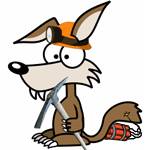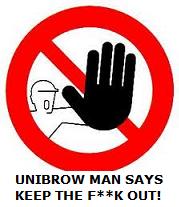 |
 |
|
UER Store
|
|
 order your copy of Access All Areas today!
order your copy of Access All Areas today!
|
 |
 |
|
Activity
|
|
720 online
Server Time:
2024-05-15 17:52:16
|
|
 |
 Therrin
    
This member has been banned. See the banlist for more information.
Location: North of Chicago, IL
Gender: Male

*Therrin puts on the penguin-suit
 | |  | |  | Re: mine mapping tools
<Reply # 20 on 9/8/2010 4:22 PM >
|  | | | See the last picture I posted that shows the narrow constricted opening?
This next picture is what that area looks like from normal ground level. There's a pile of dirt and rocks there (as there is several other places on the mountainside where there ISN'T an adit), and the adit opening isn't visible. We walked right past it the first time. Not till you crawl up ontop of the pile of rocks to you see that narrow opening. That's how hard they can be to find. And this is AFTER hiking 600 vertical feet up a rocky scree slope and traversing a mountainside via a trail less than a foot wide, which looks more like a vague depression in the ground than a trail.
1.

Give a person a match and they'll be warm for a minute, but light them on fire and they'll be warm for the rest of their life. =) |
|
Freak
     
Location: Usually Alaska, now MSP.
Gender: Male

Hypocrite
 | |  | |  | Re: mine mapping tools
<Reply # 21 on 9/8/2010 9:47 PM >
|  | | | For those of you who haven't done mines before, you should take a few extra precautions. I usually make fun of the respirator crowd for being too over-the-top on safety, but mines actually do require some additional gear and safety awareness. They're not like any other type of UE location.
You'll probably want at minimum, a helmet (caving/climbing helmet is best, hardhats are 2nd best) and good shoes and gloves (lots of opportunities to smash or scrape your hands/feet). You'll also want to be hella careful climbing around on anything underground, there can be unstable rock and hidden shafts (in ye olden days it was acceptable to throw a mattress and some dirt on a shaft and call it "sealed").
Also a map or a way to mark your route. Mines (like caves) can have completely random layouts and it's easy to get lost. I've been exploring mines for years and have very good direction sense, but I got turned around just this weekend and ended up on a completely different level than I thought I was on.
Bad air is the big one. Decaying wood and even rusting metal can eat up the oxygen in undisturbed air. Hard rock mines are generally not so bad, but coal mines generate their own dangerous/explosive gasses. Anything with a deadend tunnel or lack of moving air can be potentially dangerous.
There's lots more info on here if you do a search, like how to deal with bad air and other stuff.
Turn off the internet and go play outside.
http://spamusement...hp/comics/view/137 |
|
Therrin
    
This member has been banned. See the banlist for more information.
Location: North of Chicago, IL
Gender: Male

*Therrin puts on the penguin-suit
 | |  | |  | Re: mine mapping tools
<Reply # 22 on 9/9/2010 12:55 AM >
|  | | | As mentioned on other threads, the ebay version of gas detectors aren't worth the trouble. Generally if the cost of something is too good to be true, there's a reason for it.
However, single or double gas meters CAN be had for relatively cheap. There are models which run on a chemical process and are "always on", and last for either 1, 2, or 3 years before you discard them basically.
All of the things Freak mentioned are perfectly legit. I'd add to it though.
A headlamp is invaluable in mines. As well as a BACKUP headlamp.
If for any reason you're using ropes in mines, a headlamp is absolutely required. And if you have to use a headlamp, having a backup HEADLAMP (not hand light) is also required. I can't stress this enough. For actions which require your hands to be free to manage ropes and such, nothing else will do as well.
Just this last weekend I was explaining this to the guys on my trip. One of them had only brought one headlamp, it ended up having a bad wiring that allowed it to die when he needed it, and then he didn't have a spare headlamp to replace it with, only a hand-light.
The Fenix HP10 is quickly becoming a favored choice for mine exploring of all kinds. It has low level output that puts out enough light to see just fine and lasts forever, as well as medium, high, and boost modes that allow you to see larger spaces and far down tunnels. It runs at 7/50/200/320 lumens (i think). As well it has 3 strobes. I'm not a big fan of strobes, but if you need to signal a helicopter or search team at night, they'd come in handy for that.
I tend to use the "dipped" gloves for everything in mines except for ropework. For that I use tight-fitting leather gloves with a wrist cinch, to keep junk out of your gloves.
A hydration pack is also a good item to have. I use one made by Blackhawk. It's extremely rugged, holds 3 liters of water, you can lock off the bite-valve, and it has 2 compartments. I use it to carry spare batteries, multi-tool, basic first aid gear, spare headlamp, glow sticks, food bars, spare dust mask, etc.
A dust mask is one of the major overlooked items when exploring mines. The mine dust is often very fine, tends to clog everything from cameras to lungs, and can irritate your lungs for up to weeks after spending several hours in a mine. It can also have different chemicals/minerals in it that you don't want in your lungs. I use the N95 valved masks, as they are better when exhaling, and I've never had trouble with them, and they're comfy.
You can either use a roll of bright or florescent colored tape to mark the path you take, and on your way back just snag the pieces off the wall/beam/whatever as you pass. It also leaves a trail for people to follow incase you need to be rescued.
Letting people know where you're going to be, and what time you should be calling them by is also VERY important. Even in areas with no cell reception. Plan to drive out every day, or every other day to a reception area and "call-in". If you become trapped in an area, or even slide down a 45degree shaft and can't get out, you have a good chance of being rescued within 48 hrs if someone knows they need to be looking for you.
Ahead of time you should look up phone numbers for the local SAR crew, sherriff's office, and fire station, and leave these numbers with the person you're calling. ESPECIALLY the SAR crew or mineshaft rescue team. That information is invaluable, and can get the ball rolling a lot quicker than just a 911 call.
Sorry that the above info has nothing to do with "mapping" and such, but its essential information to know for people who are going about this hobby, and it's info that every new mineshaft explorer should be aware of.
If you EVER feel dizzy while down in a mine, QUICKLY GO BACk THE WAY YOU CAME!!! Especially without a gas detector, there are very few warning signs that your air supply is going bad.
Dizziness
Headache
Nausea
Confusion
Visual Narrowing
Are all signs that something is very wrong. Leave IMMEDIATELY.
Also beware of unused dynamite and blasting caps. They can be set off by steppign on them, knocking dirt or other debris on them, loud voice, and even radio signals emitted by walkie talkies. Don't touch any explosives even though, yeah, they're pretty fuckin cool. =)
Give a person a match and they'll be warm for a minute, but light them on fire and they'll be warm for the rest of their life. =) |
|
Urban-Explorer
  
Location: Hell's Drain
Gender: Male

 | |  | Re: mine mapping tools
<Reply # 23 on 9/9/2010 5:39 PM >
|  | | | All information put in storage.
I will be busy getting equipment, the only thing I have is rope, dust masks.
Main Site: urban-explorer.co.cc
Forum Gallery: ue-gallery.co.cc |
|
PhotoSeeker
    
Location: Sudbury
Gender: Male

MikeOnline
 | |  | |  | Re: mine mapping tools
<Reply # 24 on 9/11/2010 12:46 AM >
|  | | | <my two cents>
So, being from Canada, and a mining community as well, I figured I'd download the data for Canada from the USGS site for Google Earth.
I began checking out the mines local to me, and I have to warn you folks... I don't know about the data in the US, but what they have on Canada isn't too terribly accurate from what I've seen so far.
Many of the mines aren't even CLOSE to where they've posted them. I saw someone post earlier that the locations may be based on the claim, not the physical location of the mine, and I'll give you a BIG "perhaps" on that one.
The data about current / past producers is also in question. There are a number of mines locally that have been gone and all building demolished and the land rehabilitated that are marked here as current producers.
I'm not saying this is a bad resource, just maybe that it should be used as more of a starting place than a central source.
</my two cents>
Lots of Urban Exploration goodness at https://urbexobsession.com |
|
Therrin
    
This member has been banned. See the banlist for more information.
Location: North of Chicago, IL
Gender: Male

*Therrin puts on the penguin-suit
 | |  | |  | Re: mine mapping tools
<Reply # 25 on 9/11/2010 4:10 PM >
|  | | | Another thing about "current" and "past" producers.
Remember, the prices of precious metals has gone up tremendously. I've also seen the "current producers" label on some pretty old digs.
My guess here is that it was last labeled a producer, went into disuse, and then recently someone purchased the claim and goes there on occasion to work it alone, or with a tow-behind rig, and doesn't process a whole lot of material, but they do process some. This holds true for at least a couple mines I've been to.
On the other hand, some of the information is just old. I've a feeling that "past" means more like 1800's to early 1900's. And "current" means middle to late 1900's. "Current" as in, was currently producing, (within a time frame) though isn't now. As opposed to was producing way in the past.
So even if a mine was producing in the 1980's like the Wyoming adits at Panamint, that'd be "current"; though there's no production at this moment.
Give a person a match and they'll be warm for a minute, but light them on fire and they'll be warm for the rest of their life. =) |
|
|
|
All content and images copyright © 2002-2024 UER.CA and respective creators. Graphical Design by Crossfire.
To contact webmaster, or click to email with problems or other questions about this site:
UER CONTACT
View Terms of Service |
View Privacy Policy |
Server colocation provided by Beanfield
This page was generated for you in 203 milliseconds. Since June 23, 2002, a total of 741843812 pages have been generated.
|
|

 order your copy of Access All Areas today!
order your copy of Access All Areas today!








